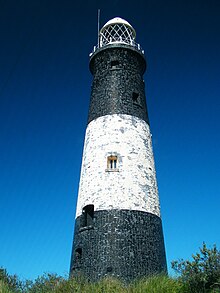Spurn Point
| Spurn Head | |
|---|---|
 Spurn in May 2005, showing the lighthouse and sand-dunes. |
|
| Spurn Head shown within the East Riding of Yorkshire | |
| Population | 50 (approx) |
| OS grid reference | TA399108 |
| Civil parish | |
| Unitary authority | |
| Ceremonial county | |
| Region | |
| Country | England |
| Sovereign state | United Kingdom |
| Post town | HULL |
| Postcode district | HU12 |
| Dialling code | 01964 |
| Police | Humberside |
| Fire | Humberside |
| Ambulance | Yorkshire |
| EU Parliament | Yorkshire and the Humber |
| UK Parliament | |

Spurn Point High Lighthouse
|
|
|
East Riding of Yorkshire
|
|
| Location | Spurn Point East Riding of Yorkshire England |
|---|---|
| Coordinates | 53°34′44″N 0°07′06″E / 53.578996°N 0.118325°E |
| Year first constructed | 1895 |
| Automated | 1957 |
| Deactivated | 1985 |
| Construction | brick tower |
| Tower shape | cylindrical tower with balcony and lantern |
| Markings / pattern | white and black bands tower, white lantern |
| Height | 39 metres (128 ft) |
| Range | 17 nautical miles (31 km) |
| Characteristic | Fl W 15s. Oc RW (sector lights) |
| Admiralty number | A2424 |
| ARLHS number | ENG-138 |
| Managing agent | Spurn Point National Nature Reserve |
Spurn (or Spurn Head Spit as it is also known) is a narrow sand spit on the tip of the coast of the East Riding of Yorkshire, England that reaches into the North Sea and forms the north bank of the mouth of the Humber estuary. It is over 3 miles (4.8 km) long, almost half the width of the estuary at that point, and as little as 50 yards (46 m) wide in places. The southernmost tip is known as Spurn Head or Spurn Point and is the home to an RNLI lifeboat station and two disused lighthouses. It forms part of the civil parish of Easington.
Spurn Head covers 280 acres (113 ha) above high water and 450 acres (181 ha) of foreshore. It has been owned since 1960 by the Yorkshire Wildlife Trust and is a designated national nature reserve, heritage coast and is part of the Humber Flats, Marshes and Coast Special Protection Area.
In the Middle Ages, Spurn Head was home to the port of Ravenspurn (a.k.a. Ravenspur or Ravensburgh), where Henry of Bolingbroke landed in 1399 on his return to dethrone Richard II. It was also where Sir Martin De La See led the local resistance against Edward IV's landing on 14 March 1471, as he was returning from his six months' exile in the Netherlands. An earlier village, closer to the point of Spurn Head, was Ravenser Odd. Along with many other villages on the Holderness coast, Ravenspurn and Ravenser Odd were lost to the encroachments of the sea, as Spurn Head, due to erosion and deposition of its sand, migrated westward.
...
Wikipedia

